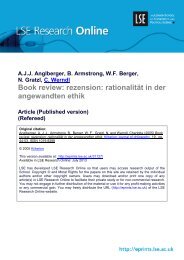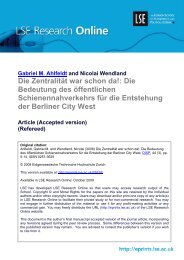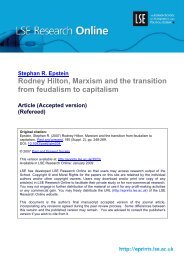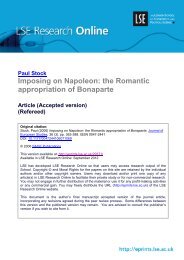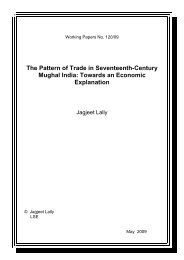Download (535Kb) - LSE Research Online - London School of ...
Download (535Kb) - LSE Research Online - London School of ...
Download (535Kb) - LSE Research Online - London School of ...
You also want an ePaper? Increase the reach of your titles
YUMPU automatically turns print PDFs into web optimized ePapers that Google loves.
Denote v = v(x1x2). Then x1 =(;v + x2ES1)D ;1 where D =(2; ES1 ; ES2) ; m ;1=2 x2. Since<br />
jf (x1x2)j C exp(;c(x 2 1 + x 2 2)) with some c>0, then for any >0,<br />
P (Vm y) =<br />
Z<br />
v y:jx1jjx2j m<br />
When jx1j jx2j m , and >0 is small, Lemma 7.1 implies<br />
f ((;v + x2ES1)D ;1 x2)(;D ;1 )dvdx2 + o(e m):<br />
D ;1 =1+hm(x2)+o(e m) hm(x2) =(e(1` )+e(2` ))(m=n) + m ;1=2 x2<br />
x1 = ;v ; vhm(x2)+e(1` )x2(m=n) + o(e m)(jvj + jx2j) =;v + o(1): (6.31)<br />
This and Taylor expansion imply<br />
P (Vm y) =<br />
Z<br />
v y:jvjjx2j m<br />
f (;v x2)+(vhm(x2) ; e(1` )x2(m=n) ) @<br />
@v f (;v x2) dvdx2 + o(e m)<br />
and integrating out x2, we arrive at the second order expansion:<br />
F (Vm v) =<br />
Z<br />
v y<br />
(v)Pm(v)dv + o(e m)<br />
where Pm(y), is quadratic in y. Comparing this expansion with (6.18) we conclude that Pm(x)<br />
1 ; m ;1=2 ep(x) where ep (6.19), as already shown, has coe cients (6.21), so that Pm(x) = 1+<br />
m ;1=2 (2 + x 2 )=3 to prove (6.28).<br />
To show (6.29) note that<br />
F ((@By) )=<br />
Z<br />
(@By) :jxij m<br />
f (x1x2)dx1dx2 + o(m ;1=2 )<br />
for any >0. By (6.30), from y = v(x1x2) we can solve forx2 = h(y x1). Thus<br />
Z<br />
C<br />
jx1j m<br />
when = m ;1; and > :<br />
Lemma 6.3 Let<br />
Z<br />
F ((@By) ) C<br />
Z<br />
(@By) :jxij m<br />
dx1dx2 + o(m ;1=2 )<br />
dx2dx1 + o(m<br />
x22[h(yx1); h(yx1)+ ]<br />
;1=2 ) C2 m + o(m ;1=2 )=o(m ;1=2 )<br />
V 0 m = Vm + e 1+<br />
m<br />
where Vm is given by (4.8), m 2X and 0 <





